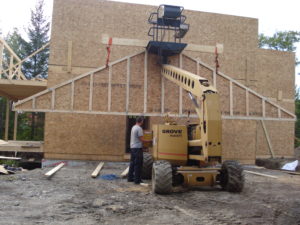
(Building my future family home)
My Curriculum Metaphor
To me curriculum is building a home to strengthen and support my students while they are in my care.
There is little I have done in my life that is more satisfying than that of building my family a home to raise my children. The construction of which began with a plan; a set of blueprints to guide me through the process. This is akin to Kieran Egan’s sense of ‘what’ in his paper What is Curriculum (1974), as blueprints are the guiding knowledge that will direct all future decisions about what must be done. It is the document that will be referred to, countless times, to ensure what is planned will be built, and in the case of students, what is planned will be learned.
The second phase of construction is no less important, but is challenging and messy work. This is the establishment of a solid foundation. A solid home is in desperate need of a strong foundation, without which, a home is not long for this world. Much like scaffolded education, without a robust base of knowledge there is nothing for the teacher to build off of, nothing for the student to refer back to – to activate prior knowledge, and nothing to tie the walls or the new knowledge down. It should be noted that care must be taken at this point to ensure everything has been constructed correctly, as mistakes here will lead to challenges later. This is true in both construction and education.
The third phase is perhaps the most enjoyable as one’s labour begins to bear fruit. Much like the taxonomy of ordered thinking, the base skills of knowledge and understanding have been established, and the walls and roof construction can begin, such as higher levels of thinking are now able to be achieved. Again, scaffolding is used here to reach these heights, and to likewise guide students in achieving all that is possible. Now only finishing is needed as the implementation of the curriculum nears completion.
My Teaching Context
My thoughts on curriculum are largely derived from my position as the Industrial Arts teacher in Fort St. James. This teaching position encompases the courses of Carpentry / Joinery, Residential Framing, Industrial Coding and Design, Metal Fabrication, Automotive Technology and more. All of these courses span the grades of 8 through 12, and encompass a large, hands-on, work space for students to learn and explore in. The Curriculum for the above courses is mandated by the British Columbia Ministry of Education and can be found here (https://curriculum.gov.bc.ca/curriculum/adst). As the Applied Design, Skills, and Technologies new curriculum is quite open it allows my students a great deal of freedom to consider multiple, project based learning opportunities, which enables them to focus on only on what needs to be learned, but how that learning is best achieved.
My Response to Egan’s and Blade’s articles
Curriculum, as posited by Egan, initially was denoted as a ‘container’ of information that was to be taught or learned by a student. This shell of a definition, however, has undergone an evolution as centuries have passed, and now seeks to not only examine what is being taught, but also how it is taught. Egan argues that by examining both the how and the what, simultaneously, curriculum “loses any comprehensible boundaries” (2003, p. 14) and instead, a strong focus on that what, is the only meaningful way to effectively address this debate. I agree with Egan that the ‘what’ is a vital aspect of curriculum, however, without including the ‘how’ misses an essential component to the pedagogy of the ways in which children learn. Information alone does not have the ability to incite learning unto our students. I believe it is of the utmost necessity that the ‘what’ is presented in a fashion that is accessible, scaffolded, and of interest to enable our children to learn.
On the other hand, Blade approaches the concept of curriculum with an extended metaphor that likens curriculum to a rack. The concept behind this metaphor is that many different objects can be hung on a rack; comparable to the many different pieces of information within the curriculum. That which I find most intriguing about this metaphor is when Blade writes “despite our efforts, however, we could only move the rack a little ways towards the door” (1997, p. 149). This enframed notion of curriculum helps me to conceptualize the challenges of trying to modify curriculum. Even with many people – it is only possible to move the curriculum slightly. Like Blade, curriculum was always “a familiar, comfortable part of my home” (p. 126). After reading these articles, however, I am more acutely aware of the complexity that surrounds this issue, and need to ensure I strike a balance between the what and the how in future planning.
References
Blades, D. (1995) Procedures of Power in a Curriculum Discourse: Conversations from Home. JCT, 11(4), 125-155.
Egan, K. (2003) What is Curriculum? JCACS, 1(1), 9-16.
Recent Comments